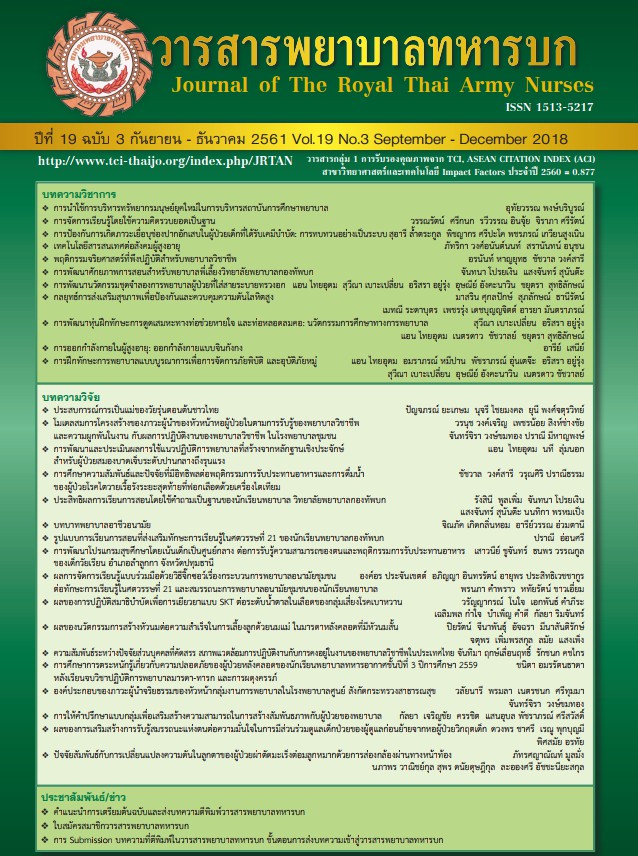Development of the Army Nurse Chest Drain Care Model
Keywords:
Innovation, Care Model, Chest DrainAbstract
Intercostal drainage (ICD) is an important life-saving procedure in managing pneumothorax and hemothorax. However, ICD carries the risk of serious complications, making nursing competence in utilizing ICDs essential in delivering care. Essential skills such as nursing care in cases of emergency incidents: chest tube displacement or broken drainage bottle cannot be trained with real patients. Unfortunately, current manikins do not present realistic models for effective training, necessitating the development of manikin model. The final model was evaluated on students’ knowledge and perceived skills related to ICD care and users’ satisfaction by the third year undergraduate nursing students of the Royal Thai Army Nursing College (n = 83) and the nursing instructors (n = 5). The results showed that ICD-care related knowledge and skills of nursing students were significantly improved after the use of the teaching innovation, compared to the baseline data (p< 0.05). The average satisfaction of the nursing students and nursing instructors were at a very high level ( X = 4.63 and 4.88 out of 5 respectively).
Downloads
References
2. Wongkornrat W. Thoracostomy. Journal of the Medical Association of Thailand. Department of Surgery, Faculty of Medicine Siriraj Hospital. 2017; 98(5):479-483. (in Thai)
3. Kittisap C. et al. Nursing Management in Chest Drainage. Clinical Nursing Practice Guideline Development for Trauma Patients with a chest drain. Central Chest Institute of Thailand. 2555, 10-35. (in Thai)
4. Sumonwong W. Nursing Care for Chest Trauma 2nd ed. Chonburi: Kamonsilp Publishing; 2007. (in Thai)
5. Boonchoochuay R. Innovative Suction Training “RTAFNC Suction Model.” Journal of The Police Nurse. 2015; 7(1): 45-52. (in Thai)
6. Prajankett O. & Prasittivejchakul A. Development of the Prototype Model for Practicing Abdominal Examination. Journal of the Royal Thai Army Nurses. 2017; 18(3): 44-50. (in Thai)
7. Boromrajonani College of Nursing Ratchaburi. Health Innovation Development. 2017 (in Thai)
8. Cant R. P. & Cooper S.J.J. Simulation-based learning in nurse education: A systematic review. Journal of Advanced Nursing. 2010; 66(1):3-15. doi: 10.1111/j. 1365-2648.2009. 05240.x.
9. Norman J. Systematic review of the literature on simulation in nursing education. The ABNF Journal. 2012; 23(2): 24-28.
10. Lateef F. Simulation-based learning: Just like the real thing. Journal of Emergencies, Trauma and Shock. 2010; 3(4): 348–352. doi: 10.4103/0974-2700.70743.
Downloads
Published
How to Cite
Issue
Section
License
บทความหรือข้อคิดเห็นใดใดที่ปรากฏในวารสารพยาบาลทหารบกเป็นวรรณกรรมของผู้เขียน ซึ่งบรรณาธิการหรือสมาคมพยาบาลทหารบก ไม่จำเป็นต้องเห็นด้วย
บทความที่ได้รับการตีพิมพ์เป็นลิขสิทธิ์ของวารสารพยาบาลทหารบก
The ideas and opinions expressed in the Journal of The Royal Thai Army Nurses are those of the authors and not necessarily those
of the editor or Royal Thai Army Nurses Association.






